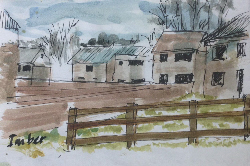Over the following years former residents and curious visitors would travel to Imber from time to time. Sometimes they went with official permission, sometimes without it. Group visits were made in 1955 and 1956, when the groups made a point of taking down the fencing around St Giles church and going into the church. According to a report in the Wiltshire News “In the churchyard grey heads of men and women bent over untidy graves, wrinkled hands deftly arranged flowers and tore away weeds and grass. One could sense their full hearts.”
Meanwhile the Ministry of Defence was taking steps to make public access to Imber more difficult. A temporary order restricting the use of public rights of way on safety grounds had been in force since 1951. From 1955 requests were made to the Ministry of Transport to make the restrictions permanent. However, at the end of 1960 the powers of the Ministry of Defence appeared to be much weakened when the Defence of the Realm Act expired. DORA had been used to sanction much of the action that had been taken to occupy Salisbury Plain and exclude the public from it.
In January 1961 the Amesbury Rural District Council expressed strong objections to the intention to close public rights of way around Imber. The opposition was led by one particular councillor, Austin Underwood, who demanded that a public inquiry should be held before any closure decision could be made. In order to assert the rights of the public to enter Imber he organised a procession from Gore Cross to Imber on Sunday 22 January.
The rally attracted enormous support. According to Rex Sawyer about 350 cars and a similar number of vans joined the procession, as well as pedestrians and those travelling by bicycle, scooter, or motor cycle. On the outskirts of Imber everyone continued on foot, following a tractor driven by Richard Hooper and carrying Austin Underwood as a passenger. Underwood’s first act was to pin a large “NOTICE TO QUIT” notice to a wall, calling on the War Department to vacate Imber. A new sign was hung outside the Bell Inn, where several people paused to drink a toast in orange juice.
Many of the people on the demonstration were former residents of Imber or others closely connected with the village. They reminisced sadly as they wandered around the remains of Imber, and several said they would wish to come back to live in Imber again.
Speeches were delivered, including one by Sydney Dean, aged 77, who mentioned that his family had farmed at Imber for over two hundred years, and Fred Daniels who had worked at Seagram’s farm. At the end of the speeches Austin Underwood called for the creation of an Association for the Restoration of Imber, a proposal that received strong support. Then a recording of church bells was played, and a short service was held, including the hymn “The Church’s One Foundation”
― whose words can be read and tune heard on the Cyber Hymnal website.
The inaugural meeting of the Association for the Restoration of Imber was held at
Devizes Town Hall on 11 February. It was agreed that its aims would be to keep open
all rights of way in the Imber area, to re-
Two further rallies were planned. One went ahead on 26 February, but was badly hampered by heavy rain. Before the next rally could be held Ministry of Defence succeeded in obtaining a temporary High Court injunction forbidding entry into the Imber Ranges. Thereafter support for the cause began to wane. The Wiltshire County Council decided to withdraw its objection to the closing of rights of way around Imber. Another rally was held on 25 June, when a procession of vehicles followed a route across Salisbury Plain that did not include the forbidden roads. However, on this occasion there was much less interest from the media.
Part of Imber, painted by Michael Riggs
